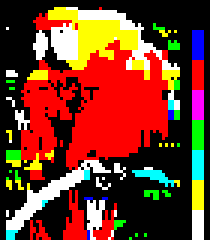SAA5050 on:
[Wikipedia]
[Google]
[Amazon]

 The Mullard SAA5050 was a
The Mullard SAA5050 was a
SAA5050 data sheet
Bedstead
a font inspired by the SAA5050 character shapes Teletext Graphics chips

 The Mullard SAA5050 was a
The Mullard SAA5050 was a character generator
A character generator, often abbreviated as CG, is a device or software that produces static or animated text (such as news crawls and credits rolls) for keying into a video stream. Modern character generators are computer-based, and they can ...
chip for implementing the Teletext character set
This article covers technical details of the character encoding system defined by ETS 300 706, a standard for World System Teletext, and used for the Viewdata
Viewdata is a Videotex implementation. It is a type of information retrieval se ...
. The SAA5050 was used in teletext
A British Ceefax football index page from October 2009, showing the three-digit page numbers for a variety of football news stories
Teletext, or broadcast teletext, is a standard for displaying text and rudimentary graphics on suitably equipp ...
-equipped television sets, viewdata terminals, and microcomputer
A microcomputer is a small, relatively inexpensive computer having a central processing unit (CPU) made out of a microprocessor. The computer also includes memory and input/output (I/O) circuitry together mounted on a printed circuit board (PC ...
s, most notably on computers like the Philips P2000 (1980), Acorn System 2 (1980), BBC Micro (1982), Malzak and the Poly-1. This chip was also manufactured by Mullard for Philips
Koninklijke Philips N.V. (), commonly shortened to Philips, is a Dutch multinational conglomerate corporation that was founded in Eindhoven in 1891. Since 1997, it has been mostly headquartered in Amsterdam, though the Benelux headquarters is ...
.
Operation
The chip generated appropriate video output for a 7-bit input character code representing the current character on the text line, while keeping track of the effect of any of the variouscontrol character
In computing and telecommunication, a control character or non-printing character (NPC) is a code point (a number) in a character set, that does not represent a written symbol. They are used as in-band signaling to cause effects other than the ...
s defined by the teletext standard that had previously occurred in that text line, which could be used to change the foreground and background colour, switch to or from the alternate block graphics character set, or various other effects.
Full-screen resolution generated by the SAA5050 was 480×500 pixels, corresponding to 40×25 characters. Each character position therefore corresponded to a 12×20 pixel space.
Internally each character shape was defined on a 5×9 pixel grid that was loosely based on the Signetics 2513 character ROM chip. This was then interpolated by smoothing diagonals to give a 10×18 pixel character, with a characteristically angular shape, surrounded to the top and to the left by two pixels of blank space. This gave a particularly stable and flicker-free arrangement on interlaced
Interlaced video (also known as interlaced scan) is a technique for doubling the perceived frame rate of a video display without consuming extra bandwidth. The interlaced signal contains two fields of a video frame captured consecutively. This ...
displays.
The alternate set of 2×3 block graphic characters were created on the same 12×20 pixel grid, so that the top two blocks were each 6×6 pixels, the middle two blocks each 6×8 pixels, and the bottom two blocks again 6×6 pixels (or two fewer in each direction, if the "separated graphics" control character had been sent).
The pixels were usually displayed with a 1.33:1 or 1.2:1 aspect ratio to give a full display close to the standard 4:3 TV aspect ratio, effectively a 400×300 or 480×400 display.
Versions
Compared to other alternative chips, the SAA5050 implemented the originalWorld System Teletext
World System Teletext (WST) is the name of a standard for encoding and displaying teletext information, which is used as the standard for teletext throughout Europe today. It was adopted into the international standard CCIR 653 (now ITU-R BT.653 ...
teletext standard (''Level 1''), which had no provision to set black for the foreground text colour. Some alternative chips at the time did allow this, as became formalized in the 1981 CEPT videotex standard.
In addition to the UK version, several variants of the chip existed with slightly different character sets for particular localizations and/or languages. These had part numbers SAA5051 (German), SAA5052 (Swedish), SAA5053 (Italian), SAA5054 (Belgian), SAA5055 (U.S. ASCII
ASCII ( ), abbreviated from American Standard Code for Information Interchange, is a character encoding standard for electronic communication. ASCII codes represent text in computers, telecommunications equipment, and other devices. Because ...
), SAA5056 (Hebrew
Hebrew (; ; ) is a Northwest Semitic language of the Afroasiatic language family. Historically, it is one of the spoken languages of the Israelites and their longest-surviving descendants, the Jews and Samaritans. It was largely preserved ...
) and SAA5057 (Cyrillic
The Cyrillic script ( ), Slavonic script or the Slavic script, is a writing system used for various languages across Eurasia. It is the designated national script in various Slavic, Turkic, Mongolic, Uralic, Caucasian and Iranic-speaking co ...
).
The SAA5050 was later superseded by the SAA5243 CCT chip, integrating a similar teletext character generator with all previously separately implemented functions such as decoding, timing and video generation. It was controlled through I2C.
See also
*Teletext character set
This article covers technical details of the character encoding system defined by ETS 300 706, a standard for World System Teletext, and used for the Viewdata
Viewdata is a Videotex implementation. It is a type of information retrieval se ...
* Viewdata
* Character generator
A character generator, often abbreviated as CG, is a device or software that produces static or animated text (such as news crawls and credits rolls) for keying into a video stream. Modern character generators are computer-based, and they can ...
References
{{reflistExternal links
SAA5050 data sheet
Bedstead
a font inspired by the SAA5050 character shapes Teletext Graphics chips